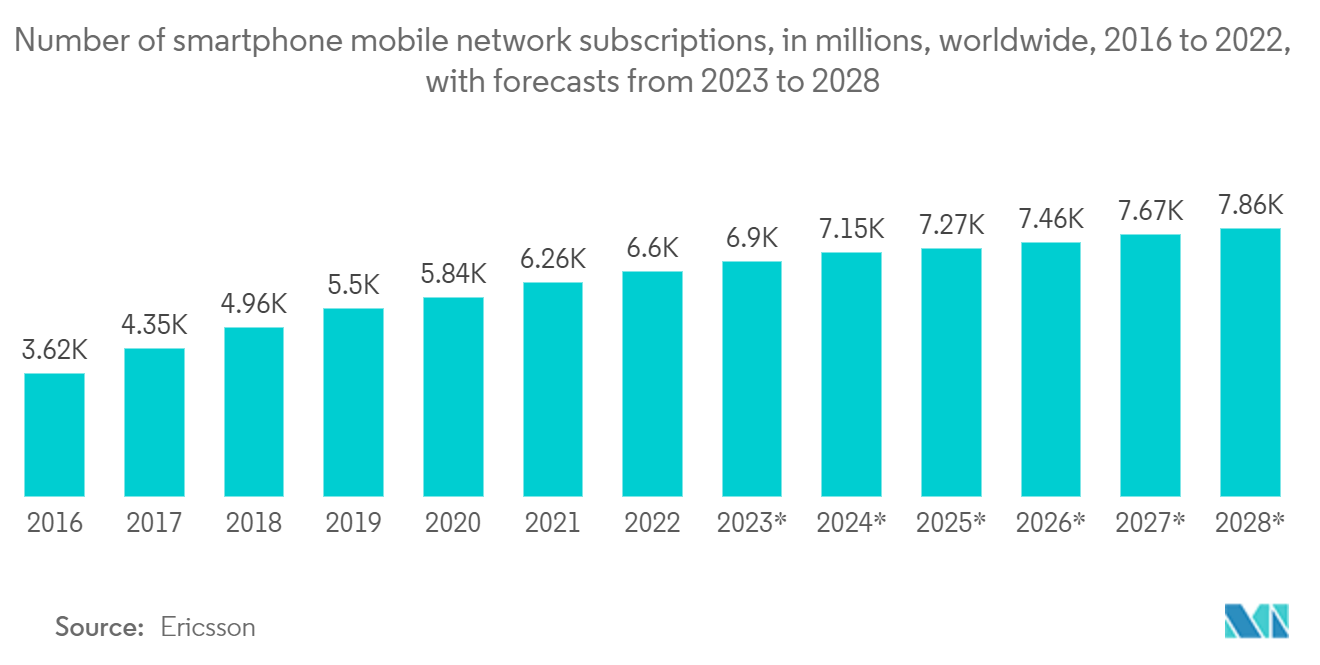Market Trends of Liquid Lens Modules Industry
The Camera Segment is Expected to Drive the Market's Growth
- A liquid lens camera is a type of camera that uses a liquid lens in place of a traditional, static optical glass lens. Liquid lenses are comprised of a small cell containing an optical-grade liquid that changes shape when a current or voltage is applied. This change in shape produces an autofocus effect, allowing the camera to adjust focus quickly and accurately. One of the main advantages of liquid lens cameras is that they provide superior image quality and auto-focus functionality compared to traditional fixed-focus lenses. They also have the ability to change focal length without any moving parts, making them more durable and reliable.
- Tunable lens technology has the potential to transform the way smartphones achieve zoom. Smartphone cameras typically simulate zoom by utilizing numerous modules, each optimized for a particular focusing distance. The information acquired by these modules is then combined with image-processing algorithms to produce a sharp photograph. Tunable lenses would allow a single camera module to adjust its focusing distance, achieving real optical zoom while reducing the number of modules required.
- To that end, in April 2021, Xiaomi collaborated with OFILM and NEXTLENS to develop the first smartphone tunable lens. Optotune's offshoot, NEXTLENS, specializes in tunable optics for scientific purposes. A transparent fluid is encased in a malleable membrane that may be sculpted by a voice coil motor system to form the liquid lens module. The liquid lens camera module can focus between 3 cm and 8 cm by operating in tandem with traditional fixed lenses. It may thus reach a 2.7x optical zoom and double as a macro and telephoto camera module, all while costing less than conventional telephoto modules featured in Samsung and Apple flagships.
- The introduction of advanced camera technologies coupled with the increasing global demand for smartphones is expected to boost the growth of the studied market. For instance, according to Ericsson, the number of smartphone subscriptions worldwide amounted to over 6,259 million in 2021 and is expected to reach 7,690 million in 2027.
- Moreover, according to GSMA, in North America, the number of smartphone subscribers is anticipated to reach 328 million by the year 2025. Moreover, by 2025, the region may witness an increase in the penetration rates of mobile subscribers (86%) and the Internet (80%). Additionally, according to GSMA, by 2025, Europe is expected to register the highest internet penetration rate (82%) and smartphones (88%). Such a huge rise in smartphones would create an opportunity for the liquid lens modules incorporated in smartphone cameras to cater to a wide range of needs of customers.

North America is Expected to Hold a Major Market Share
- North America is expected to hold a significant share of the studied market. Liquid lenses have a wide range of applications in various fields, such as machine vision, medical equipment, and more. Liquid lenses are used in machine vision systems to provide autofocus capabilities and improve image quality. Companies like Cognex, which is based in Massachusetts, offer machine vision systems that incorporate liquid lenses.
- The region is witnessing several advancements in the studied market. For instance, NASA has been developing and experimenting with liquid lenses for space exploration, including building giant space telescopes. Liquid lenses are filled with fluid that can adjust their focal length by electrowetting. They are seen as an enabler of very large optical space telescopes as they are much cheaper to construct than conventional glass mirrors. In April 2022, NASA reported that they would conduct the Fluidic Telescope Experiment (FLUTE) in the ISS, which would test liquid lenses by using water injected by polymers in microgravity through utilizing buoyancy to even gravitational forces and cause weightlessness, to be later hardened by UV light or temperature in-orbit. NASA has also tested adjustable liquid-lens eyeglasses for use in space. This would drive the demand for the liquid lens module market.
- Further, one of Canada's most notable liquid lens experiments is the Large Zenith Telescope, which used a rotating liquid-metal mirror made of mercury with a diameter of 6 meters and rotated at a rate of about 8.5 revolutions per minute. It was decommissioned due to unsuitable weather conditions at its testing site. However, plans for larger liquid-mirror telescopes, such as the ALPACA and LAMA projects, have been proposed for astronomical use. Liquid lenses have also been used in other experimental setups in Canada, such as the Fluidic Telescope Experiment (FLUTE), which investigates using liquids to construct telescope lenses. Other experimental studies have focused on liquid-liquid-vapor systems, measuring the line tension of three-phase interfaces and simulations for liquid lens setups.
- There are several references to liquid lenses and their development in Florida, particularly at the University of Central Florida's College of Optics and Photonics. Some notable developments include liquid lenses with electro-optical focus and tilt control, variable-focus liquid lenses, and adaptive dielectric liquid lenses.
- The region also has many market players who provide efficient products to cater to a wide range of needs of consumers. For instance, Baumer USA and ITALA G.EL offer industrial GigE vision cameras with liquid lens control. Cognex mentions that their barcode readers use liquid lens technology to automatically adapt to different focus distances. Lomography offers a camera called HydroChrome Sutton's Panoramic Belair Camera that has a liquid-filled lens. The presence of numerous competitors in the region is likely to boost the growth of the studied market.


